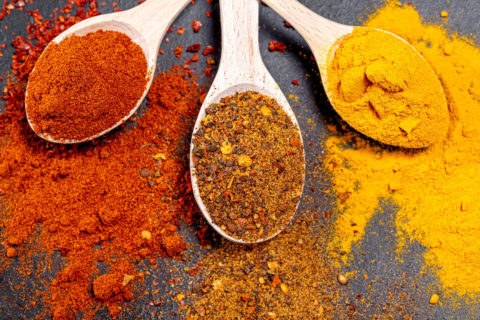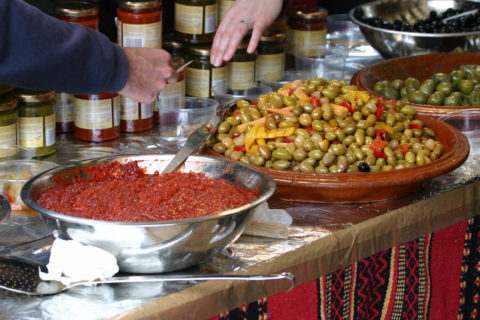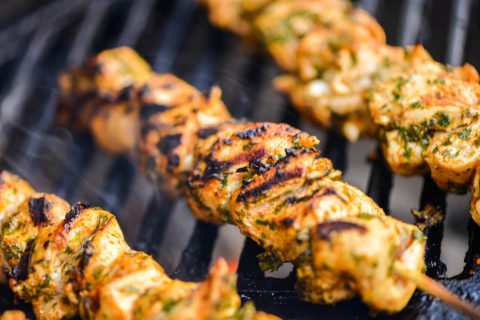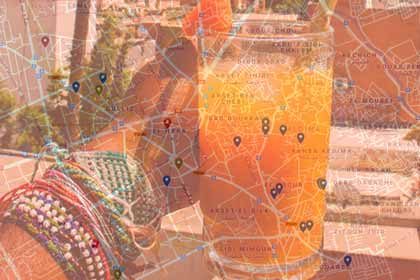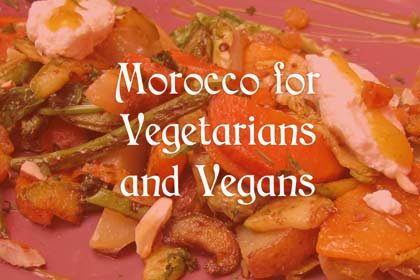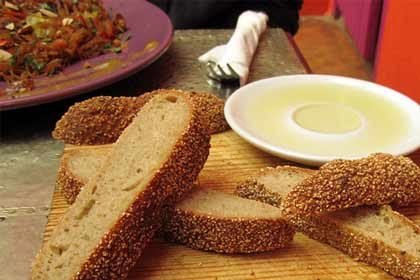Renowned as one of the world’s most precious oils, argan oil is a legendary export from the sun-drenched southwest of Morocco. This luxurious oil originates from the nut of the argan tree, which grows exclusively in this unique region. You can use it in cooking, skincare, or wellness, which makes it both versatile and valuable. In this article, you’ll learn everything there is to know about argan oil from Morocco, including how it’s made, what makes it special, and how you can incorporate it into your daily life.
For centuries, Moroccans have valued argan oil for both culinary and medicinal purposes. Today, you can enjoy it as a gourmet delicacy and a natural beauty product. Its story combines tradition, craftsmanship, and Morocco’s unique landscapes.
Contents
- 1 What is argan oil, and why is it so special?
- 2 The argan tree: The unique nature of the tree and its fruit
- 3 Geographic origin: The UNESCO Biosphere Reserve
- 4 The history and significance of argan oil in Morocco
- 5 Argan oil as an economic force for Morocco
- 6 Health & Beauty: The true benefits of argan oil
- 7 Nutritional comparison: Argan oil vs. olive oil
- 8 The labor-intensive production of argan oil
- 9 Argan oil in daily life: Culinary uses and skincare
- 10 Ensuring quality & sustainable argan oil purchases
- 11 Sustainability, social responsibility & tourist experiences: The role of women’s cooperatives
- 12 Conclusion: A Moroccan natural treasure
- 13 Frequently Asked Questions (FAQ)
What is argan oil, and why is it so special?
Argan oil is extracted from the kernels of the unique argan tree (Argania spinosa). This remarkable tree grows exclusively in the Arganeraie Biosphere Reserve, a defined region in southwestern Morocco. All attempts to cultivate the argan tree elsewhere have failed, which is why it remains a rare botanical treasure found only in this region.
Furthermore, the oil is renowned for its powerful composition, as it is rich in unsaturated fatty acids, vitamin E, and antioxidants. As a result, it boasts a golden-yellow colour, a subtle nutty scent, and—crucially—a lightweight, non-greasy texture. Ultimately, this combination of a rare origin and a potent nutrient profile makes argan oil one of the world’s most coveted and luxurious plant oils.
The argan tree: The unique nature of the tree and its fruit
The argan tree is a relic from the Tertiary period, making it one of the oldest species of trees on Earth. Remarkably, it can live up to 400 years and thrive in southern Morocco’s harsh, dry climate thanks to its deep-reaching root system. These extensive roots allow the tree to survive prolonged droughts. The tree also produces date-sized fruits, each containing an extremely hard nut that protects the precious kernels inside.
However, harvesting these fruits is labor-intensive, as it can only begin once they have fallen naturally to the ground. The tree’s thorny branches also make harvesting challenging, which is why manual labor is absolutely essential.

Geographic origin: The UNESCO Biosphere Reserve
The natural habitat of the argan tree is now limited to a specific region in southwestern Morocco, stretching between Agadir, Essaouira, and Taroudant. Spanning approximately 8,000 square kilometers, this area was designated a UNESCO Biosphere Reserve in 1998. This recognition aims to protect both the unique flora and fauna of the region and the traditional practices associated with the argan tree. Moreover, the Arganeraie is not only an ecological treasure but also a vital economic driver for local communities.
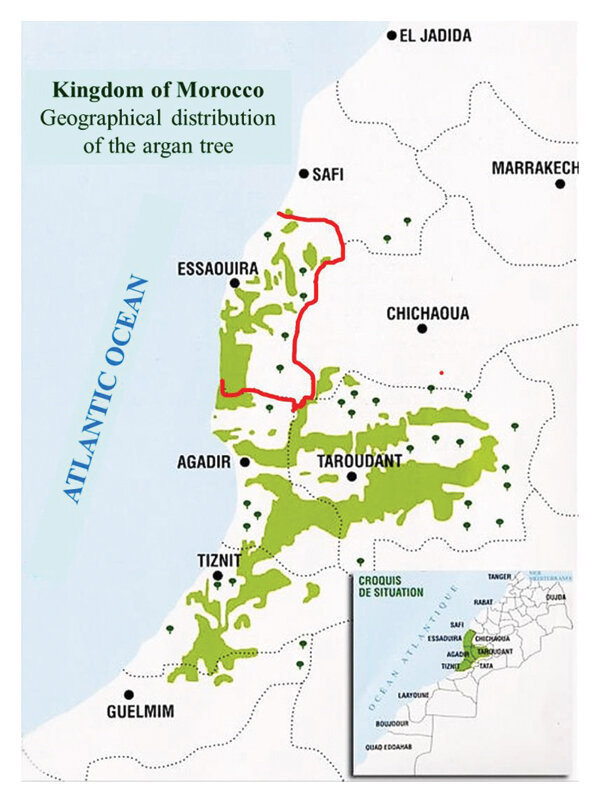
The history and significance of argan oil in Morocco
The production of argan oil in Morocco has deep roots in centuries of tradition and is closely tied to the culture of the Amazigh (Berber) people. For generations, women have carefully extracted this precious oil by hand and used it for skincare, medicinal remedies, and culinary purposes. This time-honored practice is embedded in local social structures and has led to the formation of women’s cooperatives that promote economic independence and community resilience.
Argan oil holds significant cultural value in regional customs. In fact, UNESCO recognized it as an Intangible Cultural Heritage of Humanity in 2014. Despite growing global demand, traditional production methods are essential to preserving cultural heritage and ensuring the sustainable use of precious argan forests.
Argan oil as an economic force for Morocco
Argan oil has become one of Morocco’s most valuable exports. Both production and global demand have risen significantly in recent decades. High-quality, traditionally produced argan oil can cost up to €200 per liter. This premium cost reflects the immense effort required to produce it: approximately 30 kilograms of fruit and over ten hours of labor are needed to produce just one liter of hand-pressed oil. In addition, growing demand from the global cosmetics industry has driven prices even higher.
While strong international interest has stimulated production, it has also led to increased industrialization and noticeable variations in quality. Furthermore, as the value and export of argan products continue to grow, the argan tree population is facing increasing threats from overharvesting and environmental pressures. Therefore, balancing economic opportunity with sustainable practices is essential for the future of this precious resource.
Health & Beauty: The true benefits of argan oil
For your health: A superfood packed with nutrients
Argan oil contains omega-9 and omega-6 fatty acids, vitamin E, polyphenols, and phytosterols. Thanks to its powerful composition, argan oil contributes significantly to a balanced diet and supports cardiovascular health. Furthermore, studies confirm that argan oil can positively impact cholesterol levels and provide potent antioxidant benefits.
For skin & hair: A natural beauty elixir
When applied topically, it provides intense moisture, promotes regeneration, and offers protective qualities. It strengthens the skin’s barrier, reduces the appearance of fine lines, and adds shine and softness to hair. Additionally, its high antioxidant content combats free radicals and encourages cellular renewal. As a result, argan oil is especially beneficial for dry, mature, or sensitive skin, as well as damaged or stressed hair.
Nutritional comparison: Argan oil vs. olive oil
| Nutrient / Component | Argan Oil | Olive Oil |
| Gesättigte Fettsäuren | 20% | 14% |
| Oleic Acid (Omega-9) | 42–55% | 70% |
| Linoleic Acid (Omega-6) | 30–36% | 8% |
| Linolenic Acid (Omega-3) | 0,1% | 0,9% |
| Vitamin E (Tocopherols) | ~600 mg/kg | ~320 mg/kg |
| Phytosterols | 1,3–2 g/kg | 2–4 g/kg |
| Polyphenols | present | present |
| Special Features | Gamma-Tocopherol | Alpha-Tocopherol |
| Colour | golden yellow | greenish-yellow |
| Flavour | nutty, mild | fruity, savory |
The labor-intensive production of argan oil
Harvesting and preparing the argan fruit
The argan fruit harvest takes place entirely by hand, typically during the summer months when the fruit naturally falls from the trees. After drying, workers remove the outer pulp to reveal the hard nut inside. Then, using stones, they carefully crack open the nuts to extract the valuable kernels, a delicate and labor-intensive process primarily carried out by skilled female artisans.
Manual extraction: The careful cracking process
Cracking the argan nuts is widely considered the most demanding stage of production. Once extracted, the kernels are ground by hand into a thick paste. Through continuous kneading and gradually adding water, the precious oil is slowly released. Finally, the oil is filtered multiple times to ensure purity and clarity.
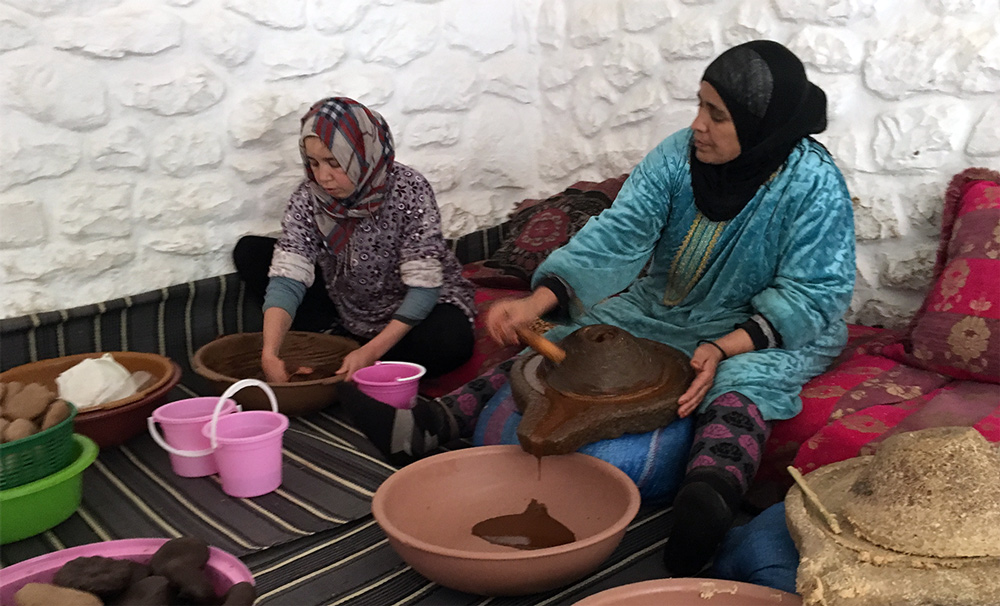
Roasting and pressing: Culinary vs. cosmetic argan oil
To achieve the distinct nutty flavor of culinary-grade argan oil, the kernels are lightly roasted before pressing. In contrast, cosmetic argan oil is made from raw, unroasted kernels to preserve its nourishing properties. Although modern mechanical presses are increasingly used for efficiency, they operate at low temperatures to maintain the oil’s natural quality and benefits.
Traditional craft vs. modern methods
Although traditional production methods are extremely time-consuming, many cooperatives continue to use them. Why? Because hand-pressed argan oil is highly valued for preserving the oil’s natural integrity. At the same time, modern presses allow for higher yields without compromising quality. Ultimately, both approaches support local communities, either by safeguarding cultural heritage or by enabling sustainable economic growth.
Argan oil in daily life: Culinary uses and skincare
In the kitchen: Ideas and recipes
Argan oil truly shines in cold dishes, where its delicate, nutty flavor is fully expressed. Often referred to as a gourmet oil, it enhances salads, traditional dips like amlou, couscous, tagines, and even desserts beautifully. For a simple treat, drizzle it over warm, toasted bread, or use it as a fragrant finishing touch for roasted vegetables.
However, remember that argan oil is not suitable for frying. High heat destroys its valuable nutrients and complex flavor. To preserve its full aroma and health benefits, always add argan oil at the very end of the cooking process, just before serving.
For skin & hair: Practical application tips
Argan oil is a true multitasking hero in the world of personal care. It is famous for its quick absorption without leaving a greasy residue.
Argan oil for skin & facial care
You can use argan oil daily as a facial and body treatment to provide intense moisture to dry skin, leaving it feeling soft and supple. Thanks to its regenerating properties, argan oil is especially beneficial for mature skin as it improves elasticity and reduces the appearance of fine lines. It also works wonderfully as a soothing after-sun treatment, calming skin that has been exposed to the sun. Those with sensitive skin will appreciate its ability to relieve itching, redness, and minor irritations. For best results, apply it directly to clean skin, or mix a few drops into your favorite cream or face mask. Whether used alone or blended with other products, argan oil delivers nourishing benefits that enhance your skincare routine.
Argan oil for hair care
Argan oil is an excellent natural shine serum that adds beautiful luminosity to your hair without weighing it down. For deep conditioning, gently massage the oil into your scalp and through your hair before washing. Then, leave it in to absorb. In addition to that, it’s also perfect for daily treatment of the ends to prevent split ends and nourish dry, brittle tips.
If your hair is dry, damaged, or over-processed, argan oil can strengthen its structure and boost softness. Best of all, just a few drops deliver visible results.
Ensuring quality & sustainable argan oil purchases
Authenticity check: Identifying genuine argan oil
To ensure you’re buying authentic argan oil, first, look for a golden-yellow to light amber hue, a subtle nutty aroma, and a silky texture that absorbs quickly without leaving a greasy residue. Additionally, a small, natural sediment at the bottom of the bottle often indicates an unrefined, high-quality product. The ingredient list should state only: “Argania spinosa kernel oil”. Finally, legitimate producers package argan oil in dark glass bottles to protect it from light and oxidation.
Purity & production: Key purchasing considerations
Always choose 100% pure, cold-pressed argan oil sourced directly from Morocco. Keep in mind that price is a strong indicator of quality—suspiciously low prices often signal diluted or poor-quality products.
Certifications: Organic and Fair Trade
Look for organic and Fair Trade certifications, which not only guarantee the oil’s purity but also ensure ethical working conditions and environmentally sustainable production. Many women’s cooperatives in Morocco hold these certifications, which support social and ecological development in the region.
Buying argan oil online: Extra tips
When shopping online, apply the same quality standards while also considering these specific points:
- Seller transparency: Choose retailers that clearly disclose the oil’s origin, production methods, and certifications.
- Customer reviews: Read feedback from previous buyers to gauge the seller’s reliability and the product’s quality.
- Product specifications: Verify whether the oil is intended for culinary (roasted) or cosmetic (unroasted) use to ensure it matches your needs.
The production of argan oil is firmly in the hands of women. In recent decades, numerous women’s cooperatives have been established across Morocco, organizing over 1,000 women in more than 22 cooperatives. Crucially, these cooperatives do more than provide an independent income; they also grant access to education and healthcare, thereby enabling women to build a secure future for themselves and their families.
Furthermore, these cooperatives play a significant role in preserving the argan forests by promoting sustainable harvesting methods and protecting this unique ecosystem. Consequently, the export of argan oil significantly strengthens the local economy and accelerates social development in rural Moroccan regions.
Many of these cooperatives welcome visitors, particularly those along the route from Marrakech to Essaouira (around 20 km before Essaouira). They offer a fascinating glimpse into the entire argan oil production process, from processing the fruit to manually cracking the nuts. Often, you can even try your hand at the various steps yourself.
During your visit, you will have the chance to taste freshly pressed argan oil. Often, amlou—a delicious local specialty made from argan oil, almonds, and honey—is served with fresh bread for sampling. You can also test and purchase cosmetic argan products on site. These visits foster an authentic connection between sustainable tourism and traditional craftsmanship, creating a deeper appreciation for the cultural and economic significance of argan oil in the region. If you are traveling by rental car or private transfer and can make individual stops, a visit here is highly recommended.
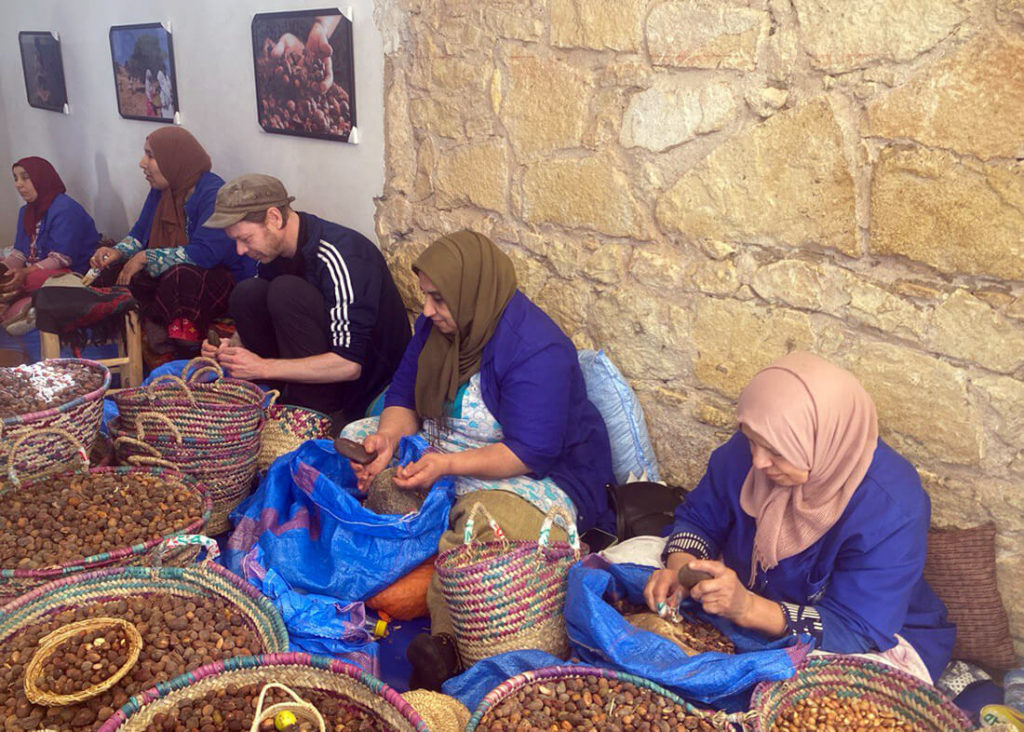
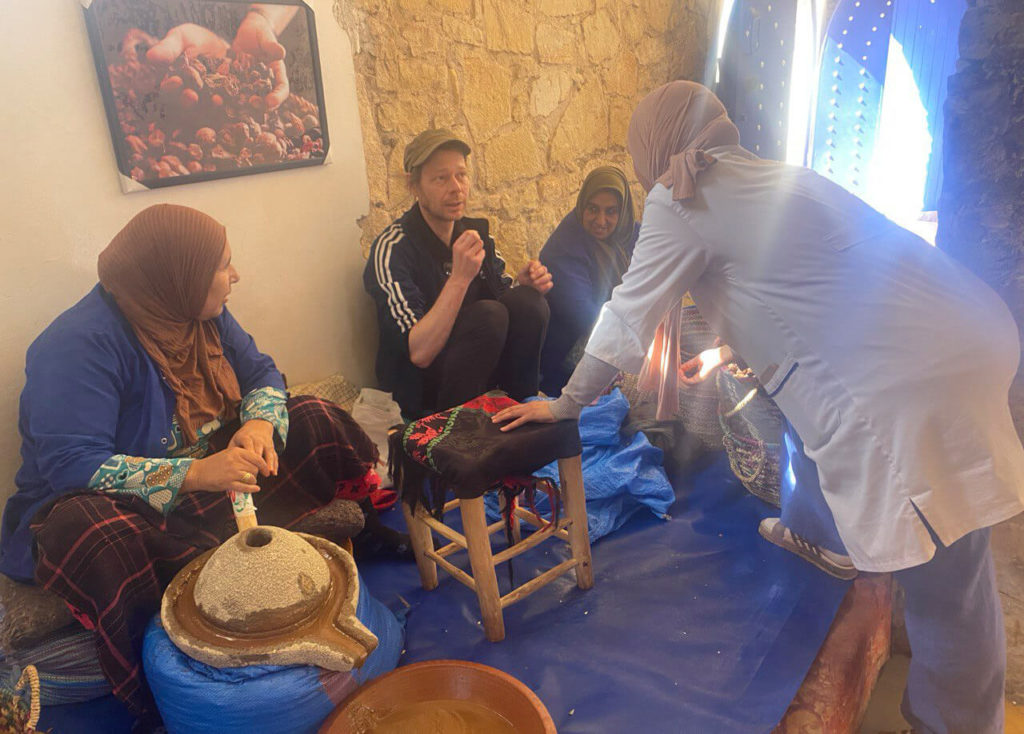
Conclusion: A Moroccan natural treasure
Argan oil is a rare and highly valued natural product. It is unique because the argan tree (Argania spinosa) grows only in southwestern Morocco, within the Arganeraie Biosphere Reserve, which UNESCO designates. All attempts to cultivate the tree elsewhere have been unsuccessful thus far, making argan oil a one-of-a-kind botanical treasure.
Its high value is significantly contributed to by the labor-intensive, traditional, handcrafted production process, which women primarily carry out. Producing just one liter of argan oil requires up to ten hours of precise manual labor, justifying its premium price. The cost also reflects a commitment to sustainable production practices and support for local women’s cooperatives.
Thanks to its valuable nutritional and cosmetic properties, argan oil is widely used in gourmet cooking and skincare. It is celebrated as a superfood and beauty elixir. Its rare origin, demanding production process, and diverse applications make argan oil a symbol of Moroccan heritage and a product of significant economic and cultural importance.
Frequently Asked Questions (FAQ)
Yes. It has anti-inflammatory properties, helps regulate sebum production, and soothes the skin. Since it is non-comedogenic, it can support clearer skin without clogging your pores.
No. It is best enjoyed in cold dishes or as a finishing touch. High heat destroys its valuable nutrients and delicate flavor.
Keep it in a cool, dry, and dark place—ideally in a dark glass bottle. Do not refrigerate it, as the oil may solidify. Culinary argan oil lasts up to 18 months, while cosmetic argan oil is best used within two months after opening.
Yes. Like any natural product, argan oil has a limited shelf life. A rancid smell or a noticeable change in colour indicates that it has gone bad and lost its effectiveness.

